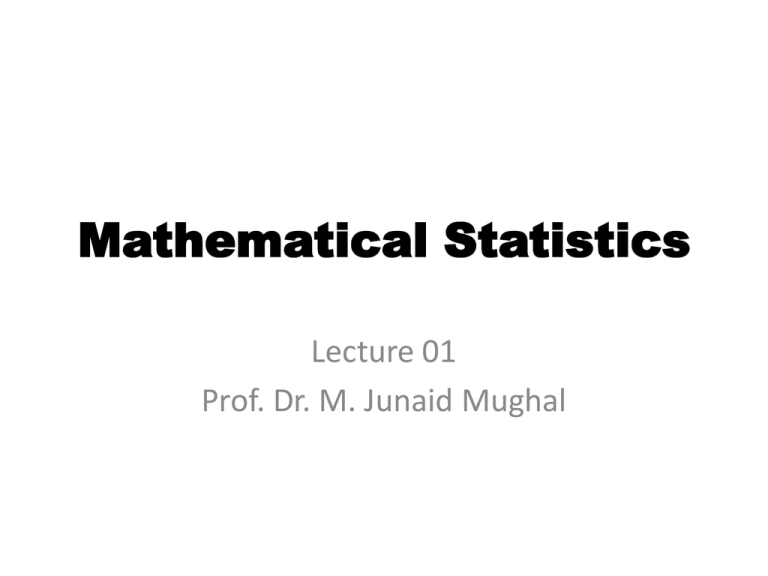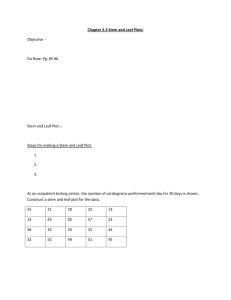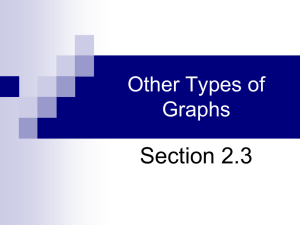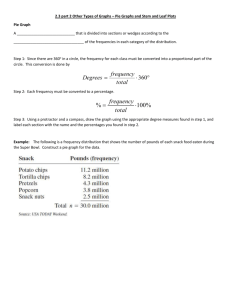STA01
advertisement

Mathematical Statistics
Lecture 01
Prof. Dr. M. Junaid Mughal
About Instructor
• MSc in Electronics (Gold Medal) and M.Phil in Electronis
(Gold Medal) 1994 and 1996 respectively from Quaid-eAzam University
• PhD in Electronics and Electrical Engineering (Merit
Scholarship) from The University of Birmingham. U.K. in
2001
• Served Nuoincs Inc. USA as Director of Engineering
from 2001 to 2003
• Joined GIK Institute, TOPI, Pakistan in 2003 as Assistant
Professor and was promoted as Associate Professor in
2006, and as Full Professor in 2012.
About Instructor (Contd…)
• In GIK, worked as
– Dean Faculty of Electronic Engineering,
– Dean Faculty of Computer Science and Engineering
– Dean Student Affairs
• Joined COMSATS, Islamabad, in July 2013 as Professor in
the Department of Electrical Engineering
• Research Interests Electromagnetics, Fiber Optics and
Communications
• Teaching Interests, High Frequency Electromagnetics,
Stochastic Processes, Microwave Engineering, Satellite and
Mobile Communications, Comm. System Design and
Performance Analysis, Electromagnetic Fields and waves,
Communication Theory, Signals and Systems, Probability and
Random Variables
Course Contents
•
•
•
•
•
•
•
•
•
•
•
•
•
•
•
Descriptive Statistics
Measure of Central Tendency
Measure of Dispersion
Measure of Skewness and Kurtosis
Mathematical theory of Probability
Permutations and Combinations
Fundamental Laws of Probability
Conditional Probability
Baye's Formula
Discrete Random Variables
Continuous Random Variables
Distribution Function
Probability Density Function
Expectation of Random Variables
Moments and Moments Generating Functions
Course Contents (Contd…)
• Comulants and Comulant Generating Functions
• Probability density functions
–
–
–
–
–
–
–
–
–
–
–
–
–
Bernoulli distribution
Binomial distribution
Geometric distribution
Negative Binomial distribution
Hypergeometric distribution
The Poisson distribution
Uniform distribution
Exponential distribution
Gamma distribution
Beta distribution
Weibul Distribution
Normal Distribution
Log Normal Distribution
Course Objectives
• At the end of this course students should be
able to understand and implement the
techniques of statistics by using mathematical
approach. It generally deals with derivations of
general expressions and theorems of statistics
and their application.
Why Statistics and Probability
• Analyses of Data in all fields
– Sciences (Natural, Social and Management)
• E.g., estimating the average number of electrons generated from a
solar cell when a known intensity of light falls on it
• If a company wants to hire a mathematician, he would need some
data about the average salary a mathematician would demand
– Engineering, Manufacturing and Industry
• E.g., it would be beneficial for the car industry to know how many
car will be needed to fulfill the demand in 2014
• Estimating the number of defective parts in manufacturing
– Governance (for surveys, planning and prediction)
• E.g, if the government is able to gather data of the current
population and the growth rate, then they would be able to estimate
the population in 2020 and can plan how many schools would be
required for the children
• Traffic light timing adjustment
Recommended Text
• Probability and Statistics for Engineers and Scientists 9th
Edition, by Walpole, Myers 2012
For Reference
• “Advanced Engineering Mathematics” by E Kreyszig
(Chapters for Statistics and Probability)
• Probability Theory and Mathematical Statistics by Marek
Fisz, 3rd Edition, 1967
• Schaums Easy Outline of Probability and Statistics
Statistics
• According to Wikipedia “Statistics is the study of the
collection, organization, analysis, interpretation and
presentation of data. It deals with all aspects of data,
including the planning of data collection in terms of the
design of surveys and experiments”.
–
–
–
–
Uncertainty is present in Data (e.g. population survey)
Variation in data (e.g. number of car at an intersection)
Data collected is used for “Inferences”
This information is used to improve the quality.
Statistical Methods
• Data: Data are values of qualitative or quantitative
variable belonging to a set of items (Wikipedia).
• Data Collection
– Simple Random Sampling
• Data collected in this process is called Raw Data
– Experimental Design
• E.g., How many people need public transport to go to cities from
villages and how often they need to go?
– Problem Definition and issues to be addressed
– Demarcation of population of interest
– Sampling
– Definition of Experimental Design
– Data Analyses
– Statistical Inference
Data Representation
• Data can be represented
– Numerically
• Numbers
– For example the age of 10 students in a M.Sc Mathematics
class can be represented as
– {20, 21, 20, 22, 23, 19, 23, 19, 20, 22}
Data Representation
• Data can be represented
– Numerically
• Grouped Data
– A raw dataset can be organized by constructing a table
showing the frequency distribution of the variable
– As in the above example we can represent the data
– {20, 21, 20, 22, 23, 19, 23, 19, 20, 22}
Age years
Number of students
19
2
20
3
21
1
22
2
23
2
Data Representation
• Data can be represented
– Numerically
• Tables
– A table is a means of arranging data in rows and columns
– e.g. age of people
Name
Age (years)
Faisal
25
Amir
29
Waqar
39
Waseem
40
Kamran
28
Data Representation
– Graphically
• Curves
Data Representation
– Graphically
• Pie Chart
– A pie chart (or a circle graph) is a circular chart divided into
sectors, illustrating numerical proportion.
– E.g., a survey of all the sportsmen in a certain country show
Data Representation
– Graphically
– Stem and Leaf plot
•
Stem-and-leaf plots are a method for showing the frequency
with which certain classes of values occur.
• For instance, suppose you have the following list of values:
– 12, 13, 21, 27, 33, 34, 35, 37, 40, 40, 41.
– We can represent it as
The "stem" is the left-hand
column which contains the tens
digits. The "leaves" are the lists in
the right-hand column, showing
all the ones digits for each of the
tens, twenties, thirties, and
forties
Data Representation
– Graphically
• Bar Chart / Histogram
– A bar chart or bar graph is a chart with rectangular bars with
lengths proportional to the values that they represent. The
bars can be plotted vertically or horizontally. A vertical bar
chart is sometimes called a column bar chart.
Data Representation (Summary)
• Data can be represented
– Numerically
• Numbers
• Grouped Data
• Tables
– Graphically
•
•
•
•
Curves
Pie Chart
Stem and Leaf plot
Bar Chart / Histogram
Data Representation (Example)
•
•
•
•
89 84 87 81 89 86 91 90 78 89 87 99 83 89
Sort this data
78 81 83 84 86 87 87 89 89 89 89 90 91 99
Group this data
– Make 5 groups
Group
No of Elements
75 - 79
1
80 - 84
3
85 - 89
7
90 - 94
2
94 - 99
1
Data Representation (Example)
• Representing this data as Bar chart
Group
No of Elements
75 - 79
1
80 - 84
3
85 - 89
7
90 - 94
2
94 - 99
1
8
7
6
5
4
3
2
1
0
75 - 79
80 - 84
85 - 89
90 - 94
94 - 99
Data Representation (Example)
• 78 81 83 84 86 87 87 89 89 89 89 90 91 99
• Representing the same data in stem and leaf plot,
Stem
Leaf
7
8
8
134
8
6779999
9
01
9
9
Data Representation (Example)
• 78 81 83 84 86 87 87 89 89 89 89 90 91 99
• Counting how many leaves a certain stem has, we write
that number in the left most column, and call it absolute
frequency
Absolute
frequency
Stem
Leaf
1
7
8
3
8
134
7
8
677999
9
2
9
01
1
9
9
Data Representation (Example)
• 78 81 83 84 86 87 87 89 89 89 89 90 91 99
• To find the cumulative absolute frequency, we add up the
absolute frequencies up to the line of the leaf
Cumulativ
e Absolute
frequency
Absolute
frequency
Group
No of
Elements
1
1
7
8
4
3
8
134
11
7
8
677999
9
13
2
9
01
14
1
9
9
Data Representation (Example)
• Individual entries of left most column in stem and leaf
plot are called Cumulative Absolute Frequency CAS, i. e.
the sum of the absolute frequencies of values up to the
line of the leaf.
– For example, 11 shows that there 11 values in the data not
exceeding 89.
• Dividing the CAS by n (total number of entries in the
data) gives Cumulative Relative Frequency .
Summary
• Introduction to the course
• What is statistics and statistical methods
• Data and its representation







